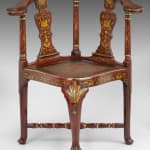Chinese Export Red Lacquer Armchair
CHINA, CIRCA 1750
87 x 65 x 65 cm
34 ¼ x 25 ½ x 25 ½ in
34 ¼ x 25 ½ x 25 ½ in
7106
Further images
-
(View a larger image of thumbnail 1
)

-
(View a larger image of thumbnail 2
)

-
(View a larger image of thumbnail 3
)

-
(View a larger image of thumbnail 4
)

-
(View a larger image of thumbnail 5
)

-
(View a larger image of thumbnail 6
)

-
(View a larger image of thumbnail 7
)

-
(View a larger image of thumbnail 8
)

-
(View a larger image of thumbnail 9
)

-
(View a larger image of thumbnail 10
)

Provenance
with Didier Aaron, Paris
where acquired by A & J Speelman Ltd, London in 1980s
Private Collection
The curved, shaped toprail continuing to form the flattened scrolling arms, above two vase-shaped splats, three turned supports and a shaped solid drop-in seat with applied inset caning, the front...
The curved, shaped toprail continuing to form the flattened scrolling arms, above two vase-shaped splats, three turned supports and a shaped solid drop-in seat with applied inset caning, the front cabriole shaped leg with a carved and gilded shell and bellflower to the knee, on a gilded claw and ball foot, the legs tied with turned and gilded X-shaped stretchers, decorated overall in red lacquer with gold floral and scrolling designs. One seat rail replaced.
The form of this chair which originated in Europe is often referred to as a corner chair. However, this is a misnomer as rather than the design allowing the chair to be placed in the corner of a room, the central front leg and the positioning of the arm supports were designed to minimise obstruction for the sitter to seat themselves at a desk or table for writing or playing cards.
This rare Chinese example is based on an English prototype. In addition to the Chinese lacquer decoration, aspects of the design such as the slightly exaggerated, higher claw and ball foot mark it out as Chinese when compared with English designs.
The first record of Chinese chairs being exported to England dates from 1726 when the East India Company brought '24 Chairs of rosewood inlaid with mother of pearl' valued at £12. Records of lacquered chairs exist from 1727 and grew significantly from the 1730s. During the mid-18th century, China's export trade was subject to stringent regulations, allowing commerce exclusively with a select number of European nations only through the ports of Canton and Shanghai. Red lacquer was particularly rare and prices for larger lacquered items were high, required advance orders and could take several years to finally reach European customers.
The form of this chair which originated in Europe is often referred to as a corner chair. However, this is a misnomer as rather than the design allowing the chair to be placed in the corner of a room, the central front leg and the positioning of the arm supports were designed to minimise obstruction for the sitter to seat themselves at a desk or table for writing or playing cards.
This rare Chinese example is based on an English prototype. In addition to the Chinese lacquer decoration, aspects of the design such as the slightly exaggerated, higher claw and ball foot mark it out as Chinese when compared with English designs.
The first record of Chinese chairs being exported to England dates from 1726 when the East India Company brought '24 Chairs of rosewood inlaid with mother of pearl' valued at £12. Records of lacquered chairs exist from 1727 and grew significantly from the 1730s. During the mid-18th century, China's export trade was subject to stringent regulations, allowing commerce exclusively with a select number of European nations only through the ports of Canton and Shanghai. Red lacquer was particularly rare and prices for larger lacquered items were high, required advance orders and could take several years to finally reach European customers.










